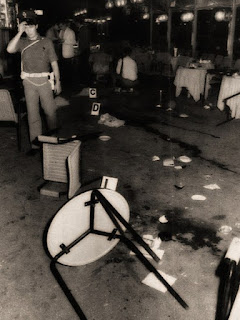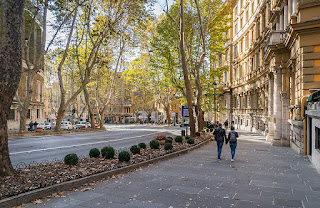Festival of San Gennaro
Worldwide celebrations for patron saint of Naples
Local worshippers, civic dignitaries and visitors meet together in the Duomo in Naples every year on this day to remember the martyrdom of the patron saint of the city, San Gennaro. Each year a service is held to enable the congregation to witness the dried blood of the saint, which is kept in a glass phial, miraculously turn to liquid. The practice of gathering blood to be kept as a relic was common at the time of the decapitation of San Gennaro in 305. The ritual of praying for the miracle of liquefaction of the blood on the anniversary of his death dates back to the 13th century. Gennaro is said to have been the Bishop of Benevento and was martyred during the Great Persecution led by the Roman Emperor Diocletian for trying to protect other Christians. His decapitation is believed to have taken place in Pozzuoli but his remains were transferred to Naples in the 15th century to be housed in the Duomo. The festival of the saint’s martyrdom is celebrated each year by Neapolitan communities all over the world and the recurrence of the miracle in Naples is televised and reported in newspapers. On 19 September in 1926, immigrants from Naples congregated along Mulberry Street in the Little Italy section of Manhattan in New York City to celebrate the Festa di San Gennaro there for the first time. Read more…
____________________________________
Italo Calvino – writer
One of 20th century Italy's most important authors
Novelist and journalist Italo Calvino died on this day in 1985 in Siena in Tuscany. Calvino was regarded as one of the most important Italian writers of fiction of the 20th century. His best known works are the Our Ancestors trilogy, written in the 1950s, the Cosmicomics collection of short stories, published in 1965, and the novels, Invisible Cities, published in 1972 and If On A Winter’s Night A Traveller, published in 1979. Both of Calvino’s parents were Italian, but he was born in Santiago de Las Vegas, a suburb of Havana in Cuba, in 1923, where his father, Mario, an agronomist and botanist, was conducting scientific experiments. Calvino’s mother, Eva, was also a botanist and a university professor. It is believed she gave Calvino the first name of Italo to remind him of his heritage. Calvino and his parents left Cuba for Italy in 1925 and settled permanently in Sanremo in Liguria, where his father’s family had an ancestral home at San Giovanni Battista. His family held the science subjects in greater esteem than the arts and Calvino, a prolific reader of stories as a child, is said to have ‘reluctantly’ studied agriculture. Read more…
_____________________________________
Umberto Bossi - politician
Fiery leader of separatist Lega Nord
Controversial politician Umberto Bossi was born on this day in 1941 in the town of Cassano Magnago in Lombardy. Until 2012, Bossi was leader of Lega Nord (Northern League), a political party whose goal was to achieve autonomy for northern Italy and establish a new independent state, to be called Padania. With his distinctive, gravelly voice and penchant for fiery, sometimes provocative rhetoric, Bossi won a place in the Senate in 1987 representing his original party, Lega Lombarda. He was dismissed as an eccentric by some in the political mainstream but under his charismatic leadership Lega Nord became a force almost overnight. Launched as Alleanza Nord in 1989, bringing together a number of regional parties including Bossi’s own Lega Lombarda, it was renamed Lega Nord in 1991 and fought the 1992 general election with stunning results. With an impressive 8.7% of the vote, Lega Nord went into the new parliament with 56 deputies and 26 senators, making it the fourth largest party in Italy. By 1996 that share had risen to 10% and Bossi had become a major figure in Italian politics. Read more…
____________________________________
Mariangela Melato - actress
Versatile star excelled on stage and screen
Mariangela Melato, who won acclaim for her work with the brilliant and sometimes controversial director Lina Wertmüller, played a camp villain in the comic book send-up Flash Gordon, and later excelled as a classical stage actress, was born on this day in 1941 in Milan. She enjoyed her peak years on screen in the 1970s, most notably in Wertmuller’s The Seduction of Mimi, Love and Anarchy and Swept Away. From the mid-80s onwards, Melato was based at the Teatro Stabile in Genoa, where she played many of the great classical parts in works by authors such as Pirandello, Euripides and Shakespeare. She made her mark in television, notably winning praise for her portrayal of Mrs Danvers in an Italian adaptation of Daphne du Maurier’s Rebecca in 2008. Melato’s father emigrated to Italy from Nazi Germany, changed his name from Honing to Melato and became a traffic policeman in Trieste. He moved to Milan and met his future wife, who worked as a seamstress. Their daughter showed a talent for art and enrolled at the Brera Academy in Milan but was interested in acting and as a teenager employed her artistic talents working as a window dresser at the Milan department store La Rinascente, which helped pay for acting lessons. Read more…
____________________________________
Giuseppe Saragat – fifth President of Italy
Socialist politician opposed Fascism and Communism
Giuseppe Saragat, who was President of the Italian Republic from 1964 to 1971, was born on this day in 1898 in Turin. As a Socialist politician, he was exiled from Italy by the Fascists in 1926. When he returned to Italy in 1943 to join the partisans, he was arrested and imprisoned by the Nazi forces occupying Rome, but he managed to escape and resume clandestine activity within the Italian Socialist Party. Saragat was born to Sardinian parents living in Turin and he graduated from the University of Turin in economics and commerce. He joined the Socialist party in 1922. During his years in exile he did various jobs in Austria and France. After returning to Italy, he was minister without portfolio in the first post-liberation cabinet of Ivanoe Bonomi in 1944. He was sent as ambassador to Paris between 1945 and 1946 and was then elected president of the Constitutional Assembly that drafted postwar Italy’s new constitution. At the Socialist Party Congress in 1947, Saragat opposed the idea of unity with the Communist Party and led those who walked out to form the Socialist Party of Italian Workers (PSLI). Read more…
_____________________________________
.jpg)





.jpg)





.jpg)
.jpg)


.jpg)
.jpg)
.jpg)








.jpg)
%20(1).jpg)



.jpg)
.jpg)
